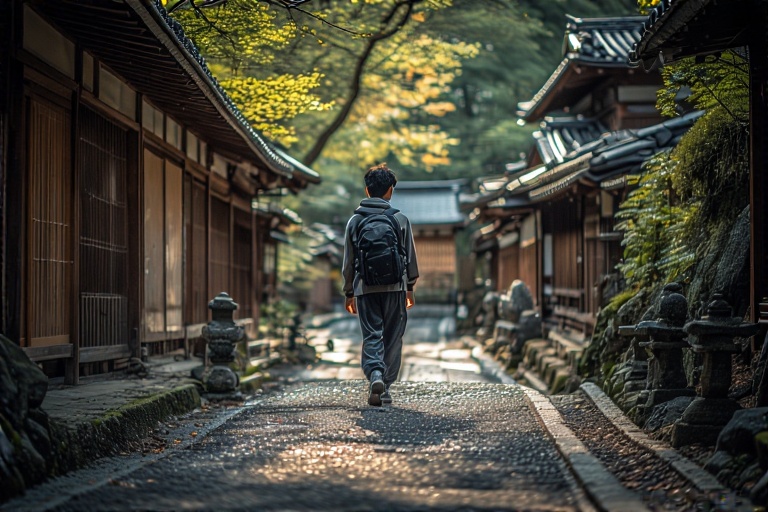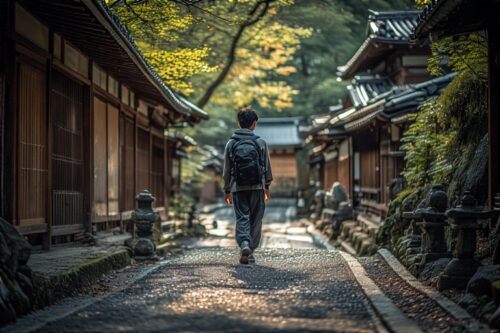

Honestly… I didn’t plan to write this.
I stumbled into Japanese walking on accident. Like, pure accident. One of those late-night doom scrolls where you’re half tired, half annoyed at your body, and fully convinced fitness influencers are lying to you.
I was frustrated. Burnt out. My knees hurt. My back felt stiff even after short walks. And regular “10k steps a day” walking? Yeah, that kinda wrecked me more than it helped.
That’s when I saw this random mention of Japanese walking. No hype. No abs-in-7-days promise. Just… walking. But done differently.
Not gonna lie — I rolled my eyes.
Still, I tried it. Mostly because it sounded easier than what I was already failing at.
Fast forward a few months, and here I am. Kinda surprised, honestly. Because the benefits of Japanese walking turned out to be very real — and very different from what I expected.
This isn’t a polished fitness article. This is me, talking to you like a friend, about what actually happened when I tried it, messed it up, fixed it, and stuck with it.
What Is Japanese Walking (in plain English)
Let me clear this up first, because the internet makes it confusing.
Japanese walking isn’t a brand. It’s not a trendy workout class. It’s a walking style that came from Japanese fitness and rehab practices.
The core idea is simple:
-
Walk upright
-
Take shorter steps
-
Land mid-foot, not heavy heel strikes
-
Keep a steady, slightly brisk pace
-
Engage your core without overthinking it
That’s it. No gear. No app. No smartwatch yelling at you.
I thought, “I already walk… how different could this be?”
Very different, actually.
Why I Even Gave It a Shot (my low point)
Little backstory.
I live part-time in a very car-heavy area. US-style suburbs. Sidewalks, but not the “walk everywhere” kind. When I did walk, I pushed too hard.
Long strides. Big arm swings. Music blasting. Felt productive… until my knees started complaining. Then my hips. Then my lower back.
I tried:
-
Normal walking → pain
-
Jogging → nope, instant regret
-
Gym treadmill → bored + sore
I wanted movement that didn’t feel like punishment.
Japanese walking showed up when I was actively looking for something gentler but not useless. That balance.
How I Started Japanese Walking (and did it wrong at first)
I wish I could say I nailed it from day one. Nope.
Week 1: Overthinking Everything
I focused too hard on posture.
-
Chest too puffed → back tension
-
Shoulders forced down → neck stiff
-
Core clenched → breathing weird
I looked… robotic. And I felt awkward.
Week 2: The “Ohhh” Moment
Then it clicked.
Japanese walking isn’t stiff. It’s relaxed alignment.
Here’s what worked for me:
-
Imagine a string gently pulling the top of your head up
-
Let shoulders hang (don’t force them)
-
Take steps a bit shorter than normal
-
Let arms swing naturally, small swings
-
Walk like you’re calm but late for coffee
That last one helped more than expected.
The First Real Benefit I Noticed: My Knees Shut Up
This shocked me.
Within two weeks, my knee pain eased. Not vanished. But noticeably better.
Why I think this happened (from my exp at least):
-
Shorter steps = less joint impact
-
Mid-foot landing = smoother load
-
Upright posture = better weight distribution
I wasn’t slamming my heels anymore. I wasn’t over-striding.
It felt… quieter. If that makes sense. My body wasn’t yelling at me after walks.
This alone made me stick with it.
Benefits of Japanese Walking for Joint Health (Underrated, honestly)
If you’ve ever searched walking benefits online, it’s all “burn calories” this and “fat loss” that.
But joint comfort? That’s life-changing.
Here’s what improved for me:
-
Knees stopped clicking as much
-
Hips felt looser after walks
-
Lower back stiffness eased
-
Ankles felt more stable
This wasn’t overnight magic. It was gradual. Sneaky, even.
One day I realized I didn’t dread walking anymore.
It Changed My Energy Levels (this one caught me off guard)
I expected soreness. Maybe some mild fitness gains.
What I didn’t expect was better daily energy.
I stopped getting that drained, heavy-leg feeling after walks.
Instead, I felt… awake. Clear-headed. Like my body liked what I was doing.
I think Japanese walking sits in this sweet spot:
-
Not too intense
-
Not too lazy
-
Stimulates circulation without stress
I started doing it in the morning. Even 20 minutes helped me focus better. Less caffeine cravings too, weirdly.
Weight Loss? Let’s Talk Honestly
Okay. Real talk.
If you’re looking for fast weight loss, Japanese walking won’t melt fat overnight. Anyone saying that is lying.
But.
Here’s what happened for me:
-
My waist slowly tightened
-
Belly bloating reduced
-
Legs looked more toned
-
I stopped stress eating as much
I think the benefits of Japanese walking for weight are indirect.
It improved:
-
Consistency (I walked more often)
-
Hormonal stress (less cortisol spikes)
-
Digestion (yep, that too)
Over 3 months, I dropped a few pounds without trying hard. No tracking. No misery.
That’s a win in my book.
The Mental Health Shift (quiet but powerful)
I didn’t expect this part.
Japanese walking feels… meditative. Not in a woo-woo way. Just calm.
Because you’re paying light attention to posture and steps, your brain doesn’t spiral as much.
It’s not like running, where thoughts race. It’s not like slow strolling, where you zone out completely.
It’s balanced.
Some days, it was the only time my mind shut up.
Anxiety didn’t vanish, but it softened. Edges blurred.
How Long Before You Notice Benefits?
People always ask this.
Here’s my honest timeline:
-
1 week: Felt awkward, slight soreness
-
2 weeks: Less knee pain
-
3–4 weeks: Better posture, more energy
-
6–8 weeks: Body composition changes
-
3 months: Walking felt natural, addictive
Your results might differ. Bodies are annoying like that.
But if nothing feels better after 3–4 weeks, you’re probably doing it too stiff or too fast.
Japanese Walking vs Regular Walking (my lived comparison)
Regular Walking (how I used to do it)
-
Long strides
-
Heel strikes
-
Music blasting
-
Pushing pace
-
Often sore after
Japanese Walking
-
Shorter, smoother steps
-
Mid-foot landing
-
Calm breathing
-
Sustainable pace
-
Felt good during and after
Same time spent. Very different outcome.
Mistakes I Made (don’t repeat these)
Let me save you some frustration.
1. Trying to “burn more calories”
I sped up too much early on. Pain crept back.
Slow down. Consistency beats intensity here.
2. Over-correcting posture
You’re not a soldier. Relax.
3. Doing it only once a week
This works best when done often. Even short walks.
4. Ignoring shoes
Thin, flexible shoes helped me feel the ground better. Bulky sneakers made me heel-strike again.
How I Do Japanese Walking Now (simple routine)
Nothing fancy.
-
Frequency: 5–6 days a week
-
Duration: 25–45 minutes
-
Surface: Sidewalks, parks, indoor mall sometimes
-
Pace: Slightly brisk but calm
-
Focus: Posture check every few minutes
Some days I go longer. Some days shorter. No guilt.
That flexibility is part of why it stuck.
Why This Works So Well for US & Canada Lifestyles
Let’s be real.
Most of us:
-
Sit too much
-
Drive everywhere
-
Have tight hips
-
Have cranky knees
-
Are stressed out
Japanese walking fits into modern life.
You can do it:
-
During lunch breaks
-
In neighborhoods
-
While listening to podcasts
-
Without gym access
-
Without looking weird
It doesn’t scream “workout.” It feels like movement we forgot how to do properly.
Is It Backed by Science?
Yes, but I won’t bore you with studies.
Short version:
-
Better gait mechanics
-
Reduced joint load
-
Improved balance
-
Enhanced posture
-
Supports cardiovascular health
But honestly? I trusted my body more than papers.
My joints don’t lie.
Who Japanese Walking Is Perfect For
From what I’ve seen:
-
People over 30 (especially)
-
Desk workers
-
Anyone with knee or back discomfort
-
Beginners to fitness
-
People burned out on workouts
If you already love HIIT, cool. This might feel slow.
But if you’re tired of hurting yourself to stay “fit,” this hits different.
Who Might Not Love It
Let’s be fair.
You might not love it if:
-
You crave intense sweat sessions
-
You get bored easily
-
You expect fast scale drops
-
You hate focusing on movement
That’s okay. Not everything works for everyone.
The Emotional Part (yeah, there is one)
This might sound dramatic, but…
Japanese walking made me trust my body again.
I stopped seeing movement as punishment. It became supportive. Gentle. Respectful.
I felt capable again.
That matters more than abs.
FAQs – From Actually Doing This
Does Japanese walking really help posture?
Yeah. Slowly, but yes. I stand taller now without thinking.
Can beginners do Japanese walking?
Absolutely. It’s beginner-friendly by design.
Is it safe for bad knees?
From my exp, yes — but start slow. If pain increases, stop.
How is it different from mindful walking?
It’s more structured. Less spiritual, more biomechanical.
Can you lose belly fat with Japanese walking?
Indirectly, yes. Through consistency and stress reduction.
Do you need special shoes?
No. But flexible shoes help a lot.
So no — Japanese walking isn’t magic.
It won’t turn you into a fitness model overnight. It won’t fix everything.
But for me? It was a quiet game changer.
It helped me move again without fear. Without pain. Without dread.
And honestly… that’s kinda everything.
If you try it, give it time. Be gentle. Don’t force it.
Your body might surprise you too.



